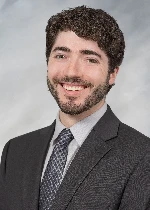3272 - Salvage Re-Irradiation for Prostate Cancer: A Contemporary Prospective Experience
Presenter(s)

S. Lichtman-Mikol1, E. T. D. O. Correia2, L. K. Bittencourt2, R. Zuhour3, N. G. Zaorsky1, K. V. Chaung1, K. A. D'Rummo1, J. E. Shoag4, R. A. Vince4, A. C. Callaway4, L. Ponsky4, P. Barata5, P. Mendiratta5, J. Brown5, J. Garcia5, D. E. Spratt1, and A. Y. Jia1; 1Department of Radiation Oncology, University Hospitals Seidman Cancer Center, Case Western Reserve University, Cleveland, OH, 2Department of Radiology, University Hospitals Cleveland Medical Center, Cleveland, OH, 3Department of Radiation Oncology, University Hospitals Cleveland Medical Center/ Seidman Cancer Center, Cleveland, OH, 4Department of Urology, University Hospitals Seidman Cancer Center, Case Western Reserve University, Cleveland, OH, 5Department of Hematology and Oncology, University Hospitals Seidman Cancer Center, Case Western Reserve University, Cleveland, OH
Purpose/Objective(s): To report the feasibility, toxicity, and preliminary outcomes of focal or whole gland stereotactic body radiotherapy (SBRT) for local recurrent prostate cancer (PCa) following definitive radiotherapy using advanced imaging such as PSMA-PET and MRI.
Materials/Methods: From 5/1/2021 to 1/17/2025, a prospective single-institutional registry enrolled 21 patients meeting eligibility criteria. Patients had prior prostate radiotherapy and biopsy-confirmed recurrence. Patients with castration-resistant disease or distant metastatic disease were excluded. Re-irradiation (Re-RT) was delivered using SBRT (35-40 Gy in 5 fractions to the dominant intraprostatic lesion (DIL), and could be used with whole gland SBRT to 25 Gy in 5 fractions). The DIL was defined on PET/CT and complimented with MRI. Toxicity (CTCAE v5.0), biochemical freedom from failure (BCFFF), and imaging outcomes were analyzed.
Results: Median age was 61 years (range, 53-72), with a median interval of 9.6 years (range, 3.7-15.6) between initial radiation treatment and salvage SBRT. Initial RT consisted of LDR brachytherapy (n=8) and external beam radiation (n=13). Median PSA at re-RT was 4.83 ng/mL (range, 1.16-43.5), and median follow-up was 16 months (range, 1-35). Concurrent ADT was given in 11 (52%). All patients underwent MRI and PET imaging at recurrence; 19 of 21 (90.5%) patients underwent PSMA-PET, while 2 of 21 (9.5%) underwent fluciclovine PET. 14 (66.7%) patients received focal SBRT, and 7 (33.3%) received whole-gland SBRT for salvage treatment. Of the 18 patients with evaluable imaging, there was concordance of the dominant lesion between MRI and PSMA PET/CT in 12 patients (66.7%). BCFFF after re-RT at 12 months was 84.6%. Two patients had subsequent recurrences—one local and one regional. Both had received partial-prostate SBRT without whole gland RT. The patient with regional recurrence underwent SBRT to the involved nodes. Acute grade 1-2 genitourinary (GU) toxicities occurred in 6 (28.6%) patients; acute grade 1 gastrointestinal (GI) toxicity occurred in 1 (4.8%) patient, with no grade 2 GI toxicities. One patient (4.8%) experienced acute grade 3 GU toxicity (gross hematuria) due to re-RT and discontinued RT. One patient (4.8%) had infiltration of a hydrogel spacer into the rectal wall prior to re-RT, requiring antibiotics; and re-RT proceeded after resolution without issue. Late grade 1-2 GU toxicities occurred in 8 (38%) patients, with no late grade 3 GU events. There were no late GI toxicities reported.
Conclusion: SBRT re-RT is a non-invasive and effective approach to salvage radio-recurrent prostate cancer, with low rates of acute grade 3+ toxicity and no late grade 3 events to date. Preliminary biochemical control appears favorable and may be improved with whole-gland prostate re-RT with a boost to the DIL. Given the lack of level 1 evidence supporting any single salvage strategy, an individualized approach remains essential, with an emphasis on enrolling patients in prospective clinical trials.
